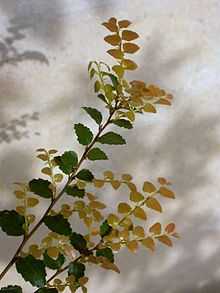Nothofagus cunninghamii
| Myrtle Beech | |
|---|---|
 | |
| Foliage with young growth | |
| Scientific classification | |
| Kingdom: | Plantae |
| (unranked): | Angiosperms |
| (unranked): | Eudicots |
| (unranked): | Rosids |
| Order: | Fagales |
| Family: | Nothofagaceae |
| Genus: | Nothofagus |
| Species: | N. cunninghamii |
| Binomial name | |
| Nothofagus cunninghamii (Hook.) Oerst. | |
Nothofagus cunninghamii, the Myrtle Beech, is an evergreen tree native to Victoria and Tasmania, Australia. It grows mainly in the temperate rainforests. It is not related to the Myrtle family.
These trees typically grow to 30–40 m (98–131 ft) tall and have large trunks with scaly, dark brown bark. Maximum height is about 55 m (180 ft). The leaves are simple and alternate, growing 1–1.5 cm (0.4–0.6 in) long, in Victoria up to 2 cm (0.8 in) long. The leaf color is dark green, with new growth brilliant red, pink or orange in spring. They are triangular with irregular minute teeth. The flowers are inconspicuous yellow-green catkins. The fruit is a 6 mm (0.24 in), capsule containing three small winged nuts.
Occasionally you will see large orange-like fruiting bodies of a fungus protruding from the trunk.
Uses and cultivation
It is an excellent cabinetry timber which is hard with strong, tough, close grain. It is a soft pink, often figured and can be polished to a fine sheen. Used for flooring, joinery, cogs of wheels, and furniture. It is harvested from old growth forest but the vast majority of the timber is left on the ground as it grows with the heavily harvested mountain ash. Density 750–880 kg/m³.
N. cunninghamii is a fairly robust species, requiring around 900 mm (35 in) of rain spread throughout the year. It grows best in the deep red mountain soils of Victoria, or in highly organic soils. It can grow in full shade, albeit slowly, through to full sun, given enough water. It is easily grown from fresh seed, germinating in a few weeks. Cuttings can be struck, although they tend to perform less well than seed grown plants. Cultivated specimens survive temperatures of 45 °C (113 °F) down to −7 °C (19 °F); though it is known that trees growing in the mountains can withstand lower temperatures at least to −15 °C (5 °F), and no source provenance selection has been made for cultivation from there. Trees cultivated in western Scotland are stout and hardy.[1]
Both N. cunninghamii and the closely related N. moorei are excellent hosts for epiphytes.
Threats
Myrtle wilt, a parasitic fungus, attacks Myrtle beech when the air-borne spores settle on open wounds. It is a natural disease of N. cunninghamii, but in recent years it has become a serious problem due to poor logging practices.
Myrtle Beech forests can not survive strong fire, and must re-establish from neighbouring areas. They can, however, survive light fires, by regenerating from seed, or sometimes vegetatively from basal epicormic shoots. Generally Myrtle Beech forests only form once a wet sclerophyll forest reaches maturity, taking several hundred years to do so.
See also
References and external links
- ↑ Letter from Crarae Garden. 1993. A list Nothofagus species growing at Crarae Garden in Scotland.
- Letter from Crarae Garden, March 1993. - 1993. A list Nothofagus species growing at Crarae Garden in Scotland.
- Wrigley. J. W. and Fagg. M. Australian Native Plants. Collins. (Australia) 1988 ISBN 0-7322-0021-0.
| ||||||||